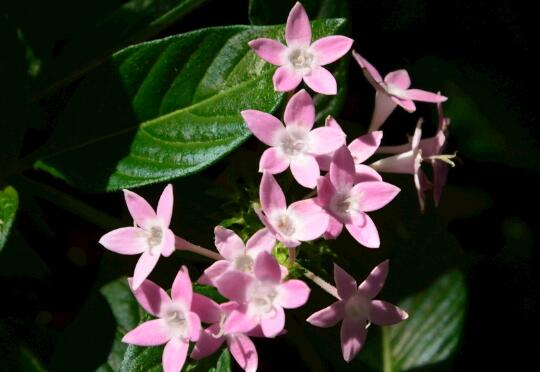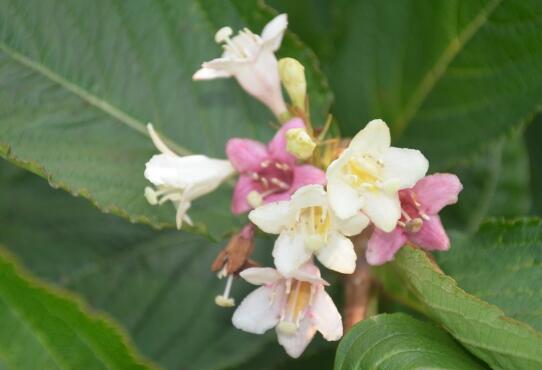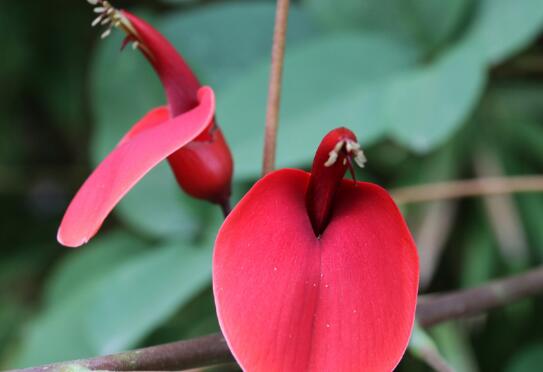What if the five-star flower grows insects? pest control of the five-star flower / 2 insect pests and 3 diseases
Plant diseases and insect pests are the most unwanted problems in the growth process of plants, and five-star flowers are no exception. Such problems are very harmful to plants, which will not only affect the beauty of plant types, but also lead to plant death if left untreated for a long time. So what if five-star flowers grow worms? What do you need to do to control pests and diseases of five-star flowers? The following small series takes everyone to understand.
5-star flowers grow insects, what to do, find out the reason

If you want to know what to do when the five-star flower grows insects, first of all, we need to know what insects grow, so that we can carry out targeted treatment on them, because the treatment methods of each pest are different. The specific details are introduced in detail below. Friends who have problems in this area can come to know about it.
II. Prevention and control of diseases and insect pests of five-star flower
1. aphids
Aphids are one of the most destructive pests on earth, harming many plants, including the five-star flower. The damage of this pest is mainly to suck leaves, stems, tender heads and tender ear sap by adult and female aphids, resulting in a large loss of nutrients and wilting of plants.
Control method: When we deal with this five-star flower pest, we can use 10% omethoate emulsion 1000 times or mala sulfur emulsion 1000-1500 times to spray it.
2. scale insects
Scale insect is a kind of pest with high incidence in the growth process of five-star flower. It mainly threatens the leaves, branches and fruits of five-star flower, resulting in its leaves gradually turning yellow and falling off, and finally the whole five-star flower will gradually wither.
Prevention and control methods: When we deal with this five-star flower pest, we can directly use 40% omethoate emulsion 1000 times to spray it, and the effect is very good.
3. sooty blotch
Coal pollution mainly threatens the leaves and branches of five-star flower. When the disease occurs, many small black mold spots will appear on the leaves and branches, and the area will gradually spread, and finally cover the whole leaves and at least, thus causing the plant to die gradually.
Control method: When we deal with the diseases and insect pests of this five-star flower, we can spray the diseased plants with 500-800 times solution of ammonium bromide or 400 times solution of sterilization pill. Generally, we spray once every 1 - 2 -15 days, and 1-2 times can cure them.
4. powdery mildew
Powdery mildew is a disease with high incidence of five-star flower. When the disease occurs, a lot of white powdery mold layers will appear on the surface of the leaves, and gradually cover the whole leaves with time, thus seriously affecting photosynthesis, causing normal metabolism to be disturbed, causing premature senescence and yield loss.
Control methods: For this five-star flower pests, we can use 75% chlorothalonil wettable powder 700 times solution to spray the diseased plants, generally 7-10 days spray once, 2-3 times after the cure.
5. leaf spot
Leaf spot disease, through its name we know that it is harmful to plant leaves, in the incidence of five-star flowers on the leaves will appear a lot of irregular spots, and with the passage of time on the spots will also appear black dots, very affecting the ornamental.
Control method: When we deal with the diseases and insect pests of this five-star flower, we can use 50% carbendazim WP 500 times solution to spray the diseased plants, generally spray once every 7-10 days, and recover after 3-4 times.
How to deal with the long-term insects of sea cucumbers, the pest control of sea cucumbers/2 pests 2 diseases
When we cultivate sea hyacinth, the last thing we want to encounter is pests and diseases. Such problems are very harmful to plants, which will not only affect their ornamental value, but also cause plants to die gradually when they are serious. So what if the hydrangea grows worms? What do you need to do to prevent and control diseases and insect pests of sea cucumbers? The following small series takes everyone to understand.
1. What should I do if the sea fairy grows worms? Find out the reason.
If you want to know what to do when the sea fairy grows insects, first of all, we need to know what kind of insects it grows, so that we can carry out targeted treatment on it, because the treatment methods of each pest are different, the specific details are introduced below, and friends who are troubled in this regard can understand.
II. Prevention and control of diseases and insect pests of Hyacinth, 2 pests and 2 diseases
1. scale insects
Scale insect is a kind of pest with high incidence in the growth process of sea cucumber. It mainly threatens the leaves, branches and fruits of sea cucumber, resulting in its leaves gradually turning yellow and falling off, and finally the whole plant will gradually wither.
Prevention and control methods: We deal with this kind of Hyacinth pests, you can directly use 40% omethoate emulsion 1000 times to spray it, the effect is very good.
2. heavenly bull
The longicorn is the general name of the family Cerambycidae, which is the most harmful to the sea fairy flower in the larval stage. The larvae will gradually watch the plant, thus hindering the normal growth of the plant, reducing the yield, weakening the tree vigor, shortening the life span, and causing the plant to wither and die rapidly when the damage is serious.
Control method: For this kind of sea cucumber pest, we can use 80% dichlorvos EC injected into the injured hole, and then use yellow mud to seal the hole, once to kill this pest.
3. leaf spot
Leaf spot is a disease that can occur on many plants, including sea cucumber. When the disease occurs, many brown spots appear on the leaves of the plant, and gradually spread, eventually causing the plant to gradually dry up and die.
Control method: For this kind of sea cucumber pest, we can use 38% cuprooxystrobin 800-1000 times solution or 80% mancozeb 400-600 times to spray the diseased plant, generally once every 10-15 days, 1-2 times can be cured.
4. rust
Rust is a disease that occurs on many plants, including Hyacinth. This disease mainly threatens the leaves, stems and fruits of plants. When the disease occurs, many small blisters will appear on the affected parts. When the blisters are serious, they will be concentrated into pieces, and the plants will die quickly.
Control methods: In the control of this kind of sea cucumber pest, we can use 20% chlorhexidine emulsifiable concentrate 400-600 times spray to spray the sea cucumber, generally spray once in about 15 days, 2-3 times after it can be cured.
How to do tennis flower long insects, tennis flower pest control/2 pests 2 diseases
In the process of breeding tennis flowers, the last thing we want to encounter is diseases and insect pests. Such problems are very harmful to plants, which not only affect the beauty of plant types, but also lead to plant death when serious. So what if tennis flowers grow worms? How do tennis flower pest control work? The following small series takes everyone to understand.
What to do when tennis flowers grow worms, find out why
If you want to know how to do tennis flower insects, first of all, we need to know what insects grow, so that we can carry out targeted treatment, because the treatment methods of each pest are different, the specific details are described in detail below, and friends who are troubled in this regard can come to know.
II. Pest control of tennis flowers (pests)
slugs
Slug is also known as slug, it is a mollusc, looks similar to a snail without protective shell, its main threat to the leaves of tennis flowers, will gradually nibble, and finally lead to the emergence of many wormholes on its leaves, very beautiful impact.
Prevention and control methods: When we deal with the pests and diseases of this tennis flower, we can use its habits of crawling out of feeding activities after watering, after rain, early morning, evening and cloudy days, and artificially catch them with iron wire.
root nematodes
Root nematode is a highly specialized omnivorous plant pathogenic nematode, which is very harmful to plants. Many red withered spots appear on the leaves at the beginning, and with time, the leaves will gradually fall off, and the plants will gradually dry up.
Control methods: When we deal with the root nematode, which is a tennis flower pest, we can use 10% gram phosphorus or 5% Yishubao to apply medicine to the plant, usually once every 5-7 days, 2-3 times can completely clear this pest.
III. Prevention and control of diseases and insect pests of tennis flowers (diseases)
rust
Rust is one of the most common diseases and insect pests of tennis flowers. This disease mainly threatens the leaves, stems and fruits of plants. When it comes to disease, many small blisters will appear on the affected parts. When it is serious, the blisters will be concentrated into pieces, and the plants will die quickly.
Control method: When rust appears on tennis flowers, we can use 50% chlorhexidine wettable powder 2000 times solution to spray it, generally spraying once every 7-10 days, 1-2 times can be cured.
powdery mildew
Powdery mildew is a disease caused by powdery mildew infection. Many white dust spots appear on the leaves of tennis flowers when the disease occurs, and gradually cover the whole leaf surface with time, resulting in the plant unable to carry out photosynthesis and gradually shrinking and dying.
Control method: If we find powdery mildew symptoms on the plant, we must treat it at the first time. When treating, we can use triadimefon 800 times liquid spray to apply medicine to the plant. Generally, the drug is applied once every 7-8 days. Generally, it can be cured by spraying three times.
- Prev

What to do when the sea immortal grows insects? pest control of sea immortal / 2 insect pests 2 diseases
When we cultivate sea immortal flowers, the last thing we want to encounter is diseases and insect pests, this kind of problem is very harmful to the plant, which will not only affect its ornamental value, but also cause the plant to die gradually. So what should I do if the sea immortal has grown worms? What should be done to prevent and control diseases and insect pests of sea immortals?
- Next

What to do with the growing insects of paulownia flowers? pest control of paulownia flowers / 2 insect pests and 4 diseases
When we cultivate paulownia flowers, the last problem we want to encounter is diseases and insect pests. This kind of problem is very harmful to the plant, which will not only affect its ornamental, but also lead to plant death. So what should I do if the paulownia flowers grow into worms? How to control the diseases and insect pests of paulownia flower
Related
- Fuxing push coffee new agricultural production and marketing class: lack of small-scale processing plants
- Jujube rice field leisure farm deep ploughing Yilan for five years to create a space for organic food and play
- Nongyu Farm-A trial of organic papaya for brave women with advanced technology
- Four points for attention in the prevention and control of diseases and insect pests of edible fungi
- How to add nutrient solution to Edible Fungi
- Is there any good way to control edible fungus mites?
- Open Inoculation Technology of Edible Fungi
- Is there any clever way to use fertilizer for edible fungus in winter?
- What agents are used to kill the pathogens of edible fungi in the mushroom shed?
- Rapid drying of Edible Fungi

